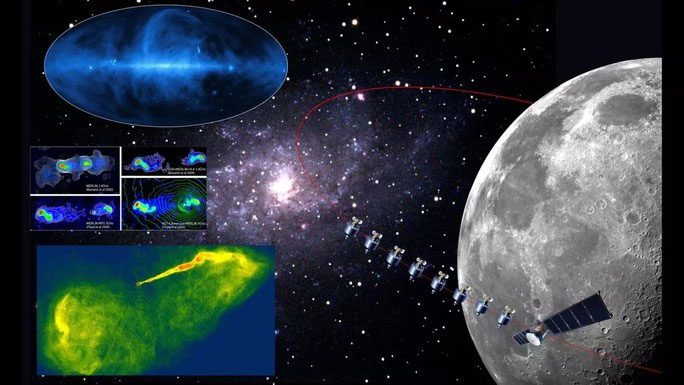According to Space, the goal of the China National Space Administration (CNSA) is to observe celestial objects that formed during the first few hundred million years after the Big Bang (13.8 billion years ago), which marks the birth of the universe.
They plan to achieve this with Hongmeng, a state-of-the-art satellite constellation consisting of one mother satellite and eight solar-powered sub-satellites, expected to be in orbit around the Moon by 2026.

Graphic depicting the Hongmeng satellite constellation that China plans to launch – (Image: CNSA).
The Hongmeng Project, also known as the “Exploring the Sky with the Longest Wavelength”, aims to optimize its vision not only through superior observational power but also due to its extremely advantageous position.
A telescope placed on Earth’s natural satellite or in orbit around it will enable scientists to observe cosmic radiation in an electromagnetic spectrum that cannot be studied from the ground: radio waves longer than 10 meters, which corresponds to a frequency below 30 MHz.
This frequency – “the final electromagnetic window of the universe” – will provide information about the “Dark Age” – the period of the first few hundred million years of the universe, when the young cosmos was filled with a seemingly impenetrable hydrogen fog.
However, atomic hydrogen emits a type of signal known as “the 21 cm line”, which has previously been used to observe nearer objects.
Observing the early universe is challenging due to the redshift effect caused by the expansion of the universe, which also “stretches” the electromagnetic radiation from distant objects, arriving at Earth with wavelengths that are too long for other telescopes to “detect.”
To “peer back in time” to the early universe, China’s observation system also leverages basic physical laws similar to other telescopes like NASA’s James Webb and Hubble: every image we see has a certain delay, which is the time it takes for light to travel from that object to us.
Thus, the image we observe of an object billions of light-years away is also a picture from billions of years ago. By observing far enough back, telescopes can reach the early universe over 13 billion years ago.
The current observational records for the farthest and oldest parts of the universe belong to the James Webb, but it still falls short of the time of the Big Bang by a few hundred million years.


















































